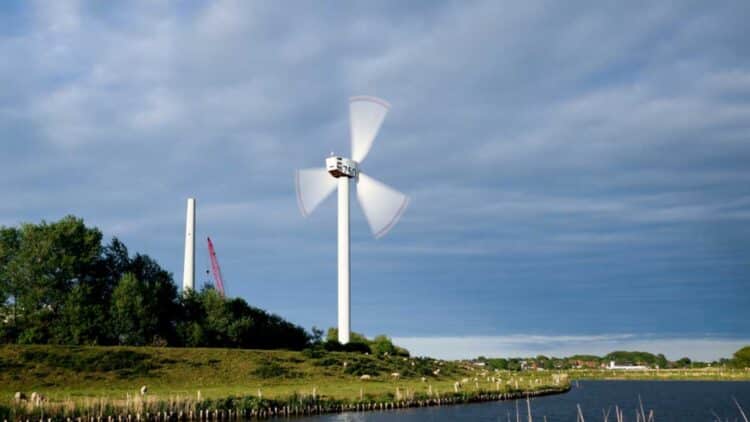A new player is emerging on the domestic renewable energy scene. While solar panels have dominated rooftops for over a decade, a 5 kW wind turbine has begun stealing the spotlight, quietly, but with the potential for real impact. It’s a compact turbine with a clever design and British technology that promises to transform backyards and properties into small wind farms. But what makes this device so special? And why might it compete with the ubiquitous photovoltaic systems?
Residential wind gets an upgrade: meet the ISKRA R9000 and its smart design
We’re talking about the ISKRA R9000, a project by the British company Evance, formerly known as Iskra Wind Turbines. Speaking more about the turbine itself, it’s a 3-blade upwind system, 5.4 meters in diameter and with a swept area of 22.9 m², which begins operating with winds as low as 2.5 m/s. This means that even locations with moderate winds can benefit from it. Some of its technical advantages include:
- Direct drive (gearless): less noise and less maintenance.
- Permanent magnet generator with axial flux: more efficient, lightweight, and innovative design.
- Blade pitch control (Reactive Pitch™): automatically adjusts blade pitch, maximizing production and preventing overload.
- Braking system (ElectroBrake™): prevents damage under extreme conditions.
And an interesting fact about it is that, unlike most small turbines, it does not use furling for speed control, which is a common but less precise system.
Sun or wind? Why the ISKRA R9000 makes the solar vs. wind debate obsolete
We must keep in mind that the comparison between solar and wind energy is often biased. After all, yes, the sun is out every day, but the wind also blows, especially in rural areas, coastal areas, and remote properties. And it is precisely in these contexts that the ISKRA R9000 shines. When comparing solar panels to the ISKRA R9000 wind turbine, some differences stand out.
The panels rely on sunlight, while the ISKRA harnesses wind as a natural resource. A typical solar panel generates between 300 and 600 of energy, while the turbine delivers 5,000 with a single unit. At night, the panels produce no energy, while the turbine continues to operate if there is wind. Finally, both operate with low noise levels; the panels are silent, and the ISKRA emits only a faint sound, even at peak speeds of up to 65 m/s.
In other words, for those seeking energy self-sufficiency, a combination of both systems can be ideal. While solar panels guarantee generation on sunny days (even through your windows, for example), the turbine covers cloudy periods, nights, and seasons with less sunlight, creating a complementary mix.
Built to last, ready to lead: why the ISKRA R9000 is winning over wind skeptics
Back in 2010, the turbine received MCS certification in the United Kingdom, which attests to its performance and safety for microgeneration. To be approved, the R9000 needed to operate for 25 hours in winds above 15.3 m/s, and well, it exceeded 200 hours. There are now over 500 installations in the United Kingdom, and the American market is beginning to wake up to its potential, driven by tax incentives and a growing appetite for clean solutions.
Not only that, the ISKRA R9000 has a 5-year warranty and requires only annual maintenance (inspection and lubrication), but it’s also more affordable than similarly priced European turbines. And, unlike low-cost “exotic machines” (common in the Asian market), it was developed with robust engineering and designed to last. Just like this first triple-power Artificial Intelligence wind turbine inaugurated in the United States.
Disclaimer: Our coverage of events affecting companies is purely informative and descriptive. Under no circumstances does it seek to promote an opinion or create a trend, nor can it be taken as investment advice or a recommendation of any kind.


